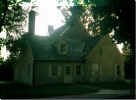George Washington
and his American Army
The winter of 1777 found the defeated and demoralized George Washington and
his American Army encamped at Valley Forge , Pennsylvania. The British
occupied Philadelphia. Both Armies needed food.
In February, 1778
Washington dispatched General "Mad" Anthony Wayne to forage for food,
cattle, and horses in South Jersey. Unfortunately, General Sir
William Howe, commander of the British Troops in Philadelphia had the same idea.
Howe sent 1,500 troops under General Charles Mawhood to enter South Jersey to requisition
food for His Majesty's Army. General Mawhood met with
considerable resistance, especially in Cumberland and Salem counties.
Mawhood wanted to punish the people of Salem County for their support of the
Americans.
 On March 21, 1778 General Mawhood gave the following command to
the British troops: "Go--Spare no one!--Give no quarter." With
help of local Tories (loyalists) acting as guides, Major John Graves Simcoe and
a force of 300 men attacked the Hancock House in the settlement of Hancock's
Bridge, NJ. British intelligence had indicated a large American force was
to be found at Hancock's Bridge. Instead, in the house of Judge William
Hancock was only the Judge and nine Continentals. It was 5 am and they
were all asleep. Not a shot was fired--all inside were bayoneted.
There were no survivors. Ironically, Judge William Hancock, was a Quaker,
and while sympathetic to the American cause, he was His Majesty's Judge for
Salem County.
On March 21, 1778 General Mawhood gave the following command to
the British troops: "Go--Spare no one!--Give no quarter." With
help of local Tories (loyalists) acting as guides, Major John Graves Simcoe and
a force of 300 men attacked the Hancock House in the settlement of Hancock's
Bridge, NJ. British intelligence had indicated a large American force was
to be found at Hancock's Bridge. Instead, in the house of Judge William
Hancock was only the Judge and nine Continentals. It was 5 am and they
were all asleep. Not a shot was fired--all inside were bayoneted.
There were no survivors. Ironically, Judge William Hancock, was a Quaker,
and while sympathetic to the American cause, he was His Majesty's Judge for
Salem County.
The British had managed no great victories. What the
British did manage to do was firm up support for the Americans in South
West Jersey and kill a British official. Within one week of the massacre
General Mawhood and his troops withdrew to Philadelphia, never to return.
There was a time when you could go up into the attic and see the blood stains on the floor
from the terrible Massacre of Judge Hancock and nine American soldiers.
Trips to the attic are no longer permitted. The State of New Jersey
feels that this will keep down on people who visit out of curiosity or a
need to feed a ghoulish desire. Though I do admit that my love of
history developed well after my curious sense of ghoulishness. For
what it's worth, the State of New Jersey should know that I was not
emotionally scarred by seeing those blood stains on the attic floor.
 The original house
was build by William and Sarah Hancock. Their initials (HWS) were inlaid
into the brickwork , along with the date of completed construction) on the upper
area of the west side of the house. This practice was common in the
construction of many Quaker houses in Salem and Cumberland counties.
The original house
was build by William and Sarah Hancock. Their initials (HWS) were inlaid
into the brickwork , along with the date of completed construction) on the upper
area of the west side of the house. This practice was common in the
construction of many Quaker houses in Salem and Cumberland counties.
A rebuilt, colonial, Swedish clapboard cabin. This
structure can be found at The Hancock House Historic Site.
The Swedes were the first European Settlers of Salem and Cumberland Counties.
They settled the area in the mid-1600's. They were followed by the Dutch,
who were soon overtaken by the British.
The Hancock House Historic Site is open to the Public Memorial Day thru Labor
Day, Wednesday thru Sunday, from 10 am to 4 pm. It is open on the 1st
& 3rd Sundays from September thru May.
 Copyright © 2001-
, Terry Muse
Copyright © 2001-
, Terry Muse
Revised: October 8, 2001
URL: http://coastalheritagetrail.tripod.com
Contact: Terry Muse
Coastal Heritage Trail | Delsea
region

 On March 21, 1778 General Mawhood gave the following command to
the British troops: "Go--Spare no one!--Give no quarter." With
help of local Tories (loyalists) acting as guides, Major John Graves Simcoe and
a force of 300 men attacked the Hancock House in the settlement of Hancock's
Bridge, NJ. British intelligence had indicated a large American force was
to be found at Hancock's Bridge. Instead, in the house of Judge William
Hancock was only the Judge and nine Continentals. It was 5 am and they
were all asleep. Not a shot was fired--all inside were bayoneted.
There were no survivors. Ironically, Judge William Hancock, was a Quaker,
and while sympathetic to the American cause, he was His Majesty's Judge for
Salem County.
On March 21, 1778 General Mawhood gave the following command to
the British troops: "Go--Spare no one!--Give no quarter." With
help of local Tories (loyalists) acting as guides, Major John Graves Simcoe and
a force of 300 men attacked the Hancock House in the settlement of Hancock's
Bridge, NJ. British intelligence had indicated a large American force was
to be found at Hancock's Bridge. Instead, in the house of Judge William
Hancock was only the Judge and nine Continentals. It was 5 am and they
were all asleep. Not a shot was fired--all inside were bayoneted.
There were no survivors. Ironically, Judge William Hancock, was a Quaker,
and while sympathetic to the American cause, he was His Majesty's Judge for
Salem County. 
 Copyright © 2001-
, Terry Muse
Copyright © 2001-
, Terry Muse